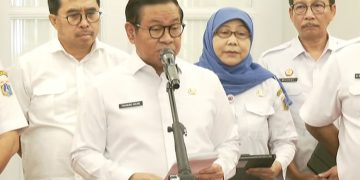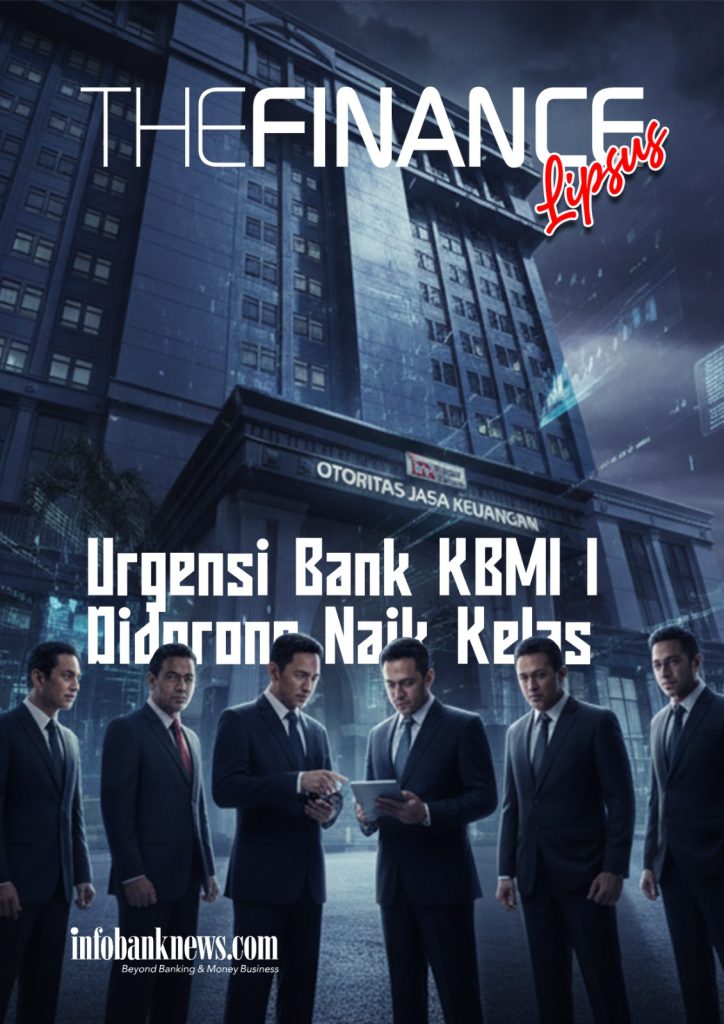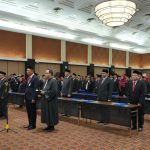Bankers of Bank Mandiri are being in the spotlight. The Ministry of SOEs (BUMN) are recruiting them. Ex Citibank bankers manage to survive. Their positions are driven by head hunters and their network. The movement of bankers from state banks is more influenced by political relations or influential people. Why is the performance of Bank Mandiri, which has been successful in educating bankers, overtaken by BRI, which havelow profile bankers? What is the difference between Mandiri Connection and BRI bankers? What happens to Gang of Niaga?
BANKERS of Bank Mandiri are proud. This is because the bank where they are building their careers become a ‘university’ for the Ministry of State-Owned Enterprises (BUMN) in seeking directors of state-owned banks. Among the 10 largest banks in Indonesia, half of them have been led by ex-Bank Mandiri’s bankers. Former Bank Mandiri’s bankers are also currently leading five regional development banks (BPD). Hence, Bank Mandiri’s Extraordinary General Meeting of Shareholders (EGMS) on 21 October was no surprise, especially, the names of Bank Mandiri bankers who will fill the board of directors’ seats have been leaked. So as many people have guessed, the Bank Mandiri’s board of directors must be filled by Bank Mandiri bankers.
It is different from the EGMS of other state banks. A month earlier, the EGMS of Bank Negara Indonesia (BNI) made a decision that made other state-owned bankers shake their heads. Many BNI directors were displaced, including those who had only worked for six months such as Herry Sidharta and Osbal Saragi. Among the 12 directors’ seats, five are filled by Bank Mandiri bankers, and BNI’s bankers only occupy three seats. It seems like BNI is changed into Bank Mandiri, the chair for president director and chief commissioner are filled by Royke Tumilaar and Agus Martowardojo.
The same thing also happens at Bank Rakyat Indonesia (BRI). The president director is Sunarso and the chief commission is occupied by Kartika Wirjoatmodjo, who is also a deputy minister of SOEs (BUMN). The dominance of Bank Mandiri bankers in state-owned banks is vivid. The number one position at Bank Tabungan Negara (BTN) is also occupied by Pahala N. Mansyuri from Bank Mandiri. Pahala replaced Maryono, who also came from Bank Mandiri and was recently caught in a case of alleged gratification.
The public has linked the movement of Bank Mandiri’s bankers with the authority held by Tiko and Budi G Sadikin (BGS) to include Bank Mandiri’s bankers in the chair of state-owned banks for a year. Understandably, both of them led Bank Mandiri and of course they know better about the key performance indicators (KPI) of Bank Mandiri’s bankers than other state-owned banks. BGS led Bank Mandiri from 2013 to 2016 and was continued by Tiko until 2019. According to Infobank source, Erick Thohir as Minister of BUMN was not too focused on handling BUMN because he took care of many things while he wanted to make improvements in the BUMN environment.
Erick, who does not master the banking field, gives the authority to his two vice ministers who had knowledge on banks. They are also given the authority in determining directors of state-owned banks. Moreover, the banking sector has been the best target for corporate governance within BUMN. What happened then is that Bank Mandiri’s bankers who got many opportunities and made other state-owned bankers hopeless. Unfortunately, when Infobank asked for information regarding to the mechanism and criteria for the appointment of state-owned banks’ management through an official letter, Tiko, who is in charge of the financial and banking sector, did not provide an answer.
However, an Infobank source, said that Agus Martowardojo has an influence. This is because he is a senior banker who is certainly respected by both Tiko and BGS. As a person who was a leader at Bank Mandiri, of course, it is only natural that Tiko and BGS ask Agus Marto’s views, especially regarding to the placement of Bank Mandiri’s bankers, who are in fact ex-subordinates.
Then, is it true that Bank Mandiri’s bankers who will be placed in the bank’s board of directors must get the blessing of Agus Martowardojo? Agus was reluctant to respond when Infobank asked about his role in the movement of Bank Mandiri’s bankers. But he said that it was very normal that a senior was asked and it happens in all aspects. “Of course, I have been consulted a lot or asked for consideration, but I am also sure that many other senior people are also used to being asked for their opinions,” he told Infobank via telephone last month.
A senior banker also admits that he is often asked for opinions and inputs. The Bank Mandiri bankers’ dominance in state-owned banks is a normal thing. “So, is that wrong? not really. Because it’s a matter of who to put trust in whom? It’s natural to trust people we know, who we know their track record, let alone know how that person works. So, let’s see the results, the results will speak,” he told Infobank last September.
However, the source continued, that Bank Mandiri, which lost its crown as the largest bank due to its position being seized by BRI in 2017, is now trying to bear a new icon as a state-owned bank that is the best in providing education. “Bank Mandiri is the result of a merger of four banks that gave birth to the largest bank both in terms of assets and profits. The position is lost, so the selling value that can be maintained is human resources. It had a former president director like Pak Agus Marto who was the minister of finance and governor of Bank Indonesia. And now the two successor directors are becoming vice ministers. That is the current value,” he said last month to Infobank.
According to Infobank’s records, Bank Mandiri is indeed the most active in conducting banker education and preparing a succession program. Since Agus Martowardojo’s leadership, Bank Mandiri has become the most successful state-owned company in conducting succession from within the organization. In fact, banker education has become a major concern for Robby Djohan, who became the first leader of a bank merged by four state-owned banks in 1998. In 1999, Bank Mandiri collaborated with the Asia Pacific Banking Institute – Citibank to organize an excellent Officer Development Program for five years, including the recruitment system, people development, talent management, performance management, and succession planning.
Previously, this pattern was also applied by Robby Djohan at Bank Niaga until this bank succeeded in producing reliable bankers and was widely used by other banks. In fact, Bank Niaga bankers, some of whom started careers at Citibank, were also the key figures behind the Bank Mandiri merger. Apart from Robby himself, there were Agus Marto, Edwin Gerungan, Peter B Stok, Glenn MS Yusuf, Agam Napitupulu, and legacy bankers such as Sigit Pramono, Wayan Agus Mertayasa, and JB Kendarto.
So, if Robby Djohan, who started his career at Citibank, admitted he did “copy and paste” in terms of banker education when leading Bank Niaga, then the source of knowledge from Citibank would be transmitted to Bank Niaga and then to Bank Mandiri. In the 2000s, ex-Niaga bankers were still scattered among the chairpersons of many banks, but after the 2010 period the next generation who were already at Bank Mandiri got the stage. Meanwhile, Citibank, which calls itself the university of bankers, has alumni who are still spreading to many banks from the past until now.
Like Citibankers, Bank Mandiri and ex-Niaga bankers look high profile. Understandably, both Citibank, Bank Niaga, and Bank Mandiri work more on the corporate market which demands knowledge, good appearance, and good taste. Comparing this with Bank Rakyat Indonesia (BRI) bankers who interact a lot with micro, small and medium enterprises (MSMEs). They are required to have a low profile and not be able to speak grandiose words in foreign terms that confuse their customers.
This was also confirmed by Infobank’s source. “ Bank Mandiri’s bankers are high profile, good in packaging and good in taste. Consultants are all around and big five consultants are used. That’s why it’s a bit westernized. But it’s not wrong because they are designed like that. However, the BRI’s banker is demanded to have a low profile, because it serves small people. The important thing is to work, not to talk much, and there are not too many concepts,” said a source who declined to be named to Infobank last month.
However, according to the person, BRI’s bankers should not be discouraged. This is because, with its work culture and business uniqueness, BRI has successfully become a reference for many world institutions as a center for microfinance. “So, if Bank Mandiri learns from global institutions such as Citibank, which is high profile. However, for BRI, global institutions such as Word Bank, Harvard and even Muhammad Yunus studied micro finance from BRI,” he said.
Besides, by working on the MSMEs market, which demands low profile bankers, BRI, which in 2005 was still the fourth largest bank, then ran quickly to overtake the three banks above it. The transformation from rural to urban and from MSMEs to consumers added to BRI’s manpower. In terms of assets, BRI overtook BNI in 2007, cut BCA in 2008, and beat Bank Mandiri in 2017.
The network of BRI bankers is actually very strong with many BRI bankers who took charge of state-owned companies until one or two years ago. In fact, senior bankers from BRI such as Krisna Wijaya were recruited by foreign financial institutions such as Temasek to become commissioners at Bank Danamon before being sold to MUFG in 2018. Later Krisna Wijaya was appointed as President Commissioner of Asset Management Companies by the Ministry of SOEs. However, when contacted by Infobank, Krisna was reluctant to provide an explanation regarding the movements of bankers in BUMN and in the private sector. According to him, bankers’ movements are interesting to watch because they can happen deliberately or follow market demand mechanisms.
Some of the big senior bankers at state-owned banks and at Citibank who are the sources of Infobank said, in contrast to the spread of Citibankers which were more driven by head hunters and their global network, the movement of bankers in SOEs circles was more driven by a “godfather” and influencers for commissioner posts. He could be a well-respected senior banker with networks or followers, but he could also be a high-ranking official with political power. “A banker to get a good position, performance and achievement is still lacking, it needs some kind of endorsement, for example from godfather, head hunter, consultant, or influencer,” he told Infobank late last month.
Bankers who only rely on the support of a godfather or political relations, but do not have the competence and integrity, of course, will not last or be trusted by the market. The COVID-19 pandemic which has a major impact on the economy will test all bankers, especially Mandiri Connection and the Citibank Gang, many of whom are now number one in banking institutions. “This crisis is an opportunity to test the real capacity of business leaders, including in banking,” Ignasius Jonan, a major senior banker at Citibank, told Infobank recently.
The crisis period will be a test that bankers who are placed to lead or become bank directors must be based on trust, not because of which gang is in power. However, the tidal wave of Bank Mandiri bankers within SOEs also needs to be used as lessons for other state-owned banks. Whether or not there is the support of godfather or political relations, state-owned banks must seriously conduct human resource education (HR). Moreover, the assessment of candidates for directors in SOEs requires the fulfillment of administrative requirements such as how often a talent conducts training. This means that great work and results are clearly not enough if you want to qualify as a director at SOEs.
However, shareholders must also establish a clear and objective measure of success. In financial theory, the measurement of a successful company that is in the interest of shareholders and management as agents is that its assets and its profits have increased greater than the industry. In the SOEs environment, is the measurement of a successful bank like Bank Mandiri which carries out banker education? Or like BRI, whose profits and assets are unmatched by other banks?
Education is very important, but a good education must produce tangible results in the form of financial performance in companies. If the company’s ability to produce leaders is not matched by significant asset growth to manage, then the bank will find it difficult to provide sufficient career opportunities for bankers who are ready to lead. Therefore, they have to venture out to look for other career advancements elsewhere. And if they are moved by the existence of political relations or those who have the authority, they can eventually dash hopes and career development for talents in other banks. (*)













